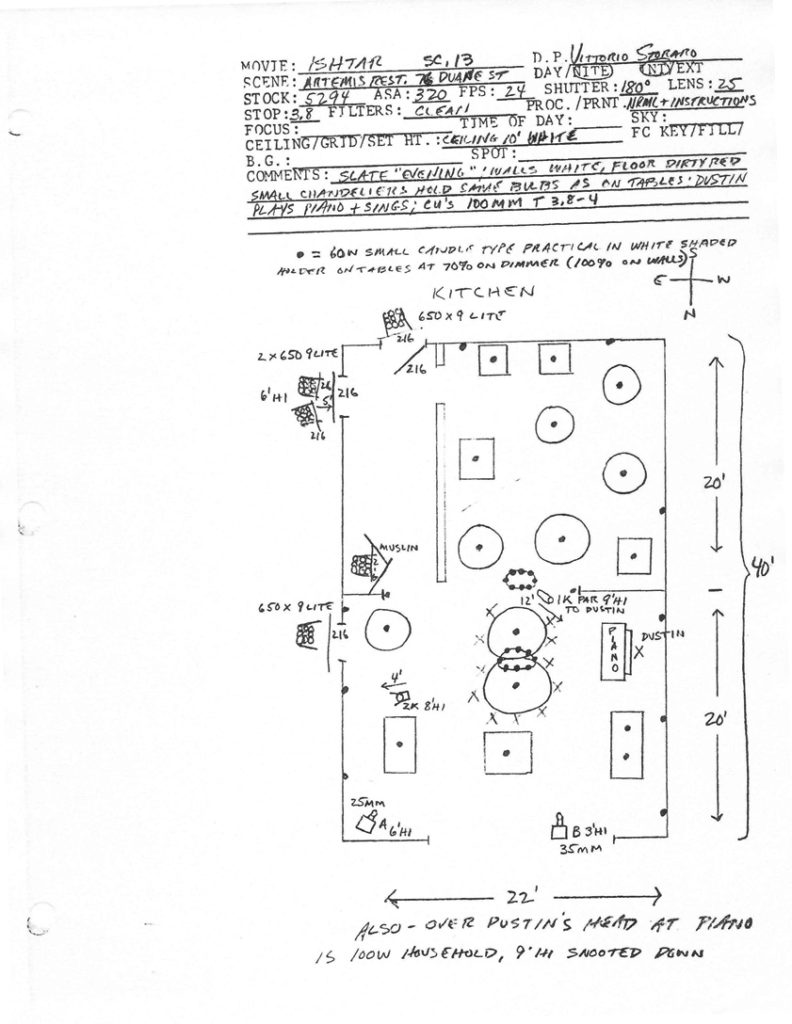This scene was shot in a practical location – a restaurant located on Duane St. in lower Manhattan. Working in the daytime, the windows were covered with layers of Duvetyne and we played it for a night\interior. The white walls and ceiling give an overall high-key feel to Storaro’s work here; even he wasn’t able to contain all the stray light bouncing around a place like this. Given the options available to such a high-budget production, it has always struck me as a peculiar choice of location. Find this scene at the 00:09:02 mark…
Dustin Hoffman’s character of Chuck Clarke entertains the diners with some cheesy songs, then joins his girlfriend for a heart-to-heart talk and meets up with partner Lyle Rogers, played by Warren Beatty.
We used two cameras on every set up and this scene was no exception. Storaro was always very careful to place them on the same axis – he never put them at anything approaching an oblique or opposing angle. This insured the integrity of his lighting and staved off the need for tasteless, inappropriate and time consuming compromises. I wish more directors would adhere to his philosophy.
Director Elaine May wanted to give the actors as much freedom as possible and tried capture the spontaneity of their performance at every turn. This led us to roll the two cameras at the start of a take and then let them go until the mags ran out…not dissimilar to the way many people like to work in today’s digital world. It was a lot more expensive to shoot that way on film as opposed to a memory card, however. I recall the production having brought 50,000′ of negative back from Morocco with them. We went through all of it in the first two days!

Dustin’s key light is coming from the 1K PAR can located about 45˚ off the camera left side. You can see its effect by the way the shadow falls on his face.


Unlike Gordon Willis, ASC – who was precise in his control of printer lights and lab processes – Storaro used a different approach. For example, the slate for each shot we did was marked for a certain effect – in this case, “Evening.” I always thought this was a bit vague and rife with the possibility of misinterpretation. But Technicolor lab manager Joe Violante knew exactly what to do. And as with everything Storaro shot, it looked beautiful.
This scene at the table marked one of the few instances in which we cross-shot the actors at the same time.




Thanks Richard,
don’t know why it took me so long to find this!
keep em coming!
g
Thanks, Richard — I always wondered where that location was. It also struck me as odd to pick a white-walled restaurant for a night scene but perhaps May and Silbert wanted to make sure it seemed like a middle-class eating establishment. There’s a warm-lit dinner table scene between Hoffman and Charles Grodin that seems to be cross-covered as well, but the table was up against a window frame with sheers so the soft source could be right next to their faces.
I used to shoot a grey scale and then a card that said basic mood things like “orange firelight” or “pale blue moonlight” etc. just so the dailies colorist would know that what he or she got after correcting for the grey card was correct, it was reinforcement. I never tried to “write down your own printer lights” approach ala Gordon Willis or Richard Kline, just because I was afraid of day-to-day variations in the soup at the lab (plus only my first three features had film dailies.) I once had a second answer print come back bright and pink and the lab said “oh, that’s just our daily variation in processing, ignore it” — but after telling the timer on every shot that it had to be less bright and less pink, we gave up and had to reprint that second answer print.
Thank you for sharing this Richard. It underscores the amount of expertise that went into this work while demystifying the craft at the same time. I feel lucky to have spoken with Joe a few times and to have seen the Hazeltine setup there. AMAZING how spoiled we are today. Also appreciate your explanation of the differences in process each cinematographer brings. Looking forward to more.
Thank you so much for doing these Richard!
Thank you, John! I hope you get something out of them…